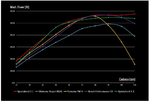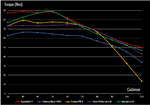mikecoin56
Member
I am currently riding an Aventon Pace 500 which I am generally pleased with. A couple annoying features though have me now looking at a mid drive bike.
The Aventon is a 500 watt, 48 volt, 50 nm, 8 speed rear hub motor ebike that is capable of ascending every hill I've tried even with my 250 pound weight. Albeit sometimes slowly.
I dislike the abrupt on-off feel of the motor due to the cadence sensor and the inability to pedal constantly in PAS 1 without going 11-12 mph.
I also dislike that the assist doesn't start helping from a stop until a pedal revolution or so.
I do like the relaxed, upright riding style as I'm 63 with some health issues.
Looking at Trek mid-drive ebikes with the 2020 Bosch Active Line Plus motor and 50 nm torque (Verve+ 3).
Or a 2020 Specialized mid-drive ebike with Brose 1.2e motor and 50 nm torque (Como 3).
Would either of these two mid drives perform as well or better on hills as the Aventon?
Do I need to go to the Electra Path Go and it's Bosch Performance line motor with 65 nm torque?
Or the Specialized Como 4 with its Brose 1.3 motor and 75 nm torque?
The Aventon is a 500 watt, 48 volt, 50 nm, 8 speed rear hub motor ebike that is capable of ascending every hill I've tried even with my 250 pound weight. Albeit sometimes slowly.
I dislike the abrupt on-off feel of the motor due to the cadence sensor and the inability to pedal constantly in PAS 1 without going 11-12 mph.
I also dislike that the assist doesn't start helping from a stop until a pedal revolution or so.
I do like the relaxed, upright riding style as I'm 63 with some health issues.
Looking at Trek mid-drive ebikes with the 2020 Bosch Active Line Plus motor and 50 nm torque (Verve+ 3).
Or a 2020 Specialized mid-drive ebike with Brose 1.2e motor and 50 nm torque (Como 3).
Would either of these two mid drives perform as well or better on hills as the Aventon?
Do I need to go to the Electra Path Go and it's Bosch Performance line motor with 65 nm torque?
Or the Specialized Como 4 with its Brose 1.3 motor and 75 nm torque?

